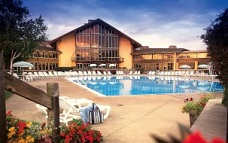 CAMBRIDGE, OHIO—On a day very soon Ohio State Park Lodges will be buying most of the food served in its restaurants from sustainable sources, generating zero hazardous waste and significantly decreasing greenhouse gas emissions. At least that is the goal for five Ohio State Park Lodges operated by concessioner Xanterra Parks & Resorts.
CAMBRIDGE, OHIO—On a day very soon Ohio State Park Lodges will be buying most of the food served in its restaurants from sustainable sources, generating zero hazardous waste and significantly decreasing greenhouse gas emissions. At least that is the goal for five Ohio State Park Lodges operated by concessioner Xanterra Parks & Resorts.
“Our sustainability practices permeate every aspect of our operations—rooms, restaurants, gift shops, swimming pools, marinas—you name it, and as new technologies and products become available, we take a fresh look at what we are doing to see if we can improve upon it,” said Greg Woodland, regional manager of Ohio State Park Lodges and Punderson State Park Lodge in northeast Ohio near Newbury, Ohio. “And although we have made significant progress over a period of many years, we know there are always more improvements to be made. We take our mission of providing legacy hospitality with a softer footprint very seriously.”
An example of Xanterra’s expanding sustainability strategies can be found in the five lodges—Mohican State Park Lodge in north central Ohio near Loudonville, Salt Fork State Park Lodge in central Ohio near Cambridge, Maumee Bay State Park Lodge in northwest Ohio near Toledo and Deer Creek State Park Lodge near Columbus.
Aggressive Companywide Goals
Xanterra Parks & Resorts has committed to reach a set of aggressive goals company-wide by 2015. Those goals include decreasing greenhouse gas emissions by 30 percent, decreasing fossil fuel usage by 30 percent, increasing purchases of sustainable food items to 50 percent of all companywide food expenditures and decreasing water usage by 25 percent. A complete list of the company’s 2015 Environmental Vision Goals can be found online along with a report with details about Xanterra’s wide ranging environmental projects at other operations in such locations as Yellowstone and Grand Canyon National Parks.
“Because each of the five lodges is distinctive and they share little in common in terms of size, age and architectural style, there are unique challenges to be met in each location,” Woodland said. “Whenever possible we turn challenges into opportunities. At Maumee Bay State Park Lodge on Lake Erie, for example, the high winds of the northwest Ohio lake region provided us with incentive to install a wind turbine.”
Other environmental initiatives at Ohio State Park Lodges include:
• Installing motion-detecting light sensors in guestrooms and public bathrooms.
• Installing low-flow plumbing fixtures in guestrooms and public bathrooms.
• Eliminating all incandescent light bulbs and replacing them with LED bulbs.
• Replacing older fluorescent bulbs with higher efficiency bulbs.
• Donating all usable mattresses, televisions and other furniture, fixtures and equipment to charities.
• Offering locally made, grown or purchased products like wines and gift items in all retail shops.
• Serving locally grown produce in restaurants whenever possible.
• Expanding and continually improving training programs stressing proactive environmental practices.
• Expanding and improving guest communications to explain and provide examples of the lodges’ initiatives. For example, several lodges are hoping to communicate with tech-savvy younger guests by downloading QR codes like those found in magazines to the global positioning units used for geocaching, a popular activity. The codes lead visitors to environmental projects like the wind turbine.
• Using Green Seal-certified cleaning products.
• Using dispensers for hand soap, lotion, shampoo and conditioner.
• Partnering with the Coca-Cola Co. to use energy-efficient vending machines.
• Serving local and sustainable beer and wine.
• Discontinuing the use of Styrofoam.
• Installing composting waste bins.
• Installing a new building control system that includes room and cabin thermostats at Salt Fork State Park Lodge that can be remotely controlled. These allow for efficient control of temperatures in empty rooms.
• Upgrading the HVAC system in Deer Creek State Park Lodge. This much-needed improvement will also include wireless room thermostats and other improvements.
• Developing and maintaining a vegetable and herb garden at Punderson State Park Lodge.
• Enlisting third-party verification systems such as the Marine Stewardship Council and EPA Energy Star Partner to maintain the highest level of transparency. These organizations certify that the environmental claims made by Ohio State Park Lodges are accurate.
“The ‘road to sustainability’ doesn’t really have an end point; it’s a journey, but we are still committed to proceeding at as brisk a pace as possible,” Woodland said. “There is always more that we can do, and we intend to seriously and continuously explore ways to have an ever-softer footprint on Ohio’s state parks.”
Click here for more information.






